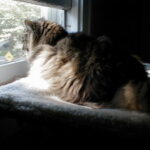Sometimes also referred to as nasopharyngeal polyps, ear polyps are a rare but serious condition. Though this growths are benign, they can cause serious damage. Though these polyps are rare, they do appear to affect cats somewhere around one year old up to four years of age, with no breed or sex predisposition.
Causes of Feline Ear Polyps
Currently, the cause of feline ear polyps is unknown though many veterinarians have various speculations. Some state that nasopharyngeal polyps may be the result of an inflammation, either due to a virus, a fungi or bacteria.
Meanwhile, other theories include that brachial arch remnants leftover from fetus development may be present in the cat, resulting in the polyp growth.
Whatever the cause, should you notice any symptoms of ear polyps in your cat, be sure to seek out veterinary attention immediately.
Symptoms of Ear Polyps in Cats
Cats with polyps often do not display any symptoms immediately. As the polyps grow in size, the cat may begin to suffer from various ailments that may cause you to think that the cat is simply suffering from a kitty cold. This includes symptoms such as nasal discharge, sneezing, difficulty breathing and change in voice; according to the American College of Veterinary Surgeons.
Additional symptoms of feline polyps include gagging, difficulty swallowing, snoring, drainage from the ear and drainage within the ear. Drainage can vary in color and consistency with some drainages being thick or bloody. Cats may suffer from head shaking, pawing at the affected ear, head tilt or have unusual changes in their eyes’ pupil shapes. In some instances, droopy eyes, a protruding third eyelid or an inability to walk in a straight light may also occur.
Diagnosis and Treatment of Nasopharyngeal Polyps in Felines
For cats, ear polyps can often be identified using an otoscope, which aids the veterinarian in fully examining the cat’s ear canal. For some cats, sedation may be necessary, as these polyps can cause severe pain for the affected cat; and examining the area may only aggravate the cat.
Once confirmed, many vets will take a sample of the polyp to rule out cancer as a cause. The veterinarian may also check for various infections, as those will also need to be treated.
Treatment will vary based on the location of the polyp. Polyps that have occurred in the pharynx can be removed surgically, but they may grow back if they have spread into the ear canal. In the ear canal, these polyps will also need to be surgically removed. Surgery can vary in severity, as some polyps will penetrate the ear drum and this too, will need to be removed.
With surgical removal, the base of the polyp must also be removed. If the base is left behind, there is a chance (up to 75% in some cases,) that the polyp will reoccur within eight months.
After surgery, owners can expect their cat to make a full recovery though some permanent nerve damage may occur if the polyp was severe. This could cause the eyelid to remain drooped or the cat may have some lack of coordination during the following weeks. For many cats, these symptoms will clear up during the healing process but in rare cases, this damage may be permanent.
—-
Additional Information:
ACVS.org: Nasopharyngeal Polyps in Cats
Pet Education: Ear Polyps in Cats
Pet Place: Nasopharyngeal Polyps in Cats





